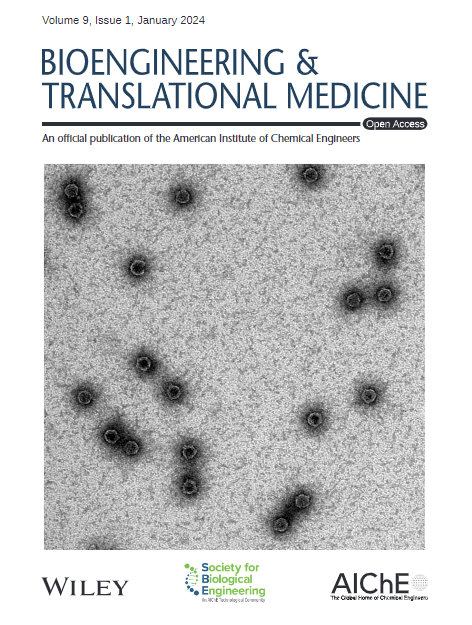生物相容性光电植入物对外周伤害性神经元的光遗传学调控
IF 6.1
2区 医学
Q1 ENGINEERING, BIOMEDICAL
引用次数: 0
摘要
外周感觉神经元的高兴奋性在慢性疼痛的发生和维持中起着关键作用。临床使用的药理学镇痛药可减少神经元活动。它们通常伴随着不可忽视的副作用。光遗传学方法可以调节神经元活动,并且在治疗用途上吸引了越来越多的兴趣,但是在身体不同部位的光传递需要开发特定的光电接口。我们设计并制造了一种微型光电植入物,将黄光(559 nm)传递到坐骨神经上。我们通过手术将该装置植入了在伤害神经元中表达黄光敏感抑制古紫红质(ArchT)的转基因小鼠中。黄光显著降低了损伤神经元的反应,抑制了对有害机械和热刺激的行为反应。值得注意的是,黄光相关的抑制并没有改变由无害的机械刺激或强烈炎症引起的行为反应。光电植入物表现出可靠和可重复的光电性能。对于体内使用的刺激参数(3.3 V, 60-80 mW/mm2, 20 s序列脉冲,1 Hz, 80%占空比,训练间隔1 s),在模拟肌肉和脂肪包围的神经组织的环境中测量有限的温度升高。同样,植入小鼠的基础灵敏度与未植入小鼠相当,表明软电子设备的安全集成。我们的研究证实,为坐骨神经量身定制的光电植入物可以为光致动器提供足够水平的特定光谱和强度,从而触发疼痛感知中的显着电生理和行为反应。本文章由计算机程序翻译,如有差异,请以英文原文为准。
Optogenetic modulation of peripheral nociceptive neurons with biocompatible optoelectronic implants
Hyperexcitability of peripheral sensory neurons plays a critical role in the development and maintenance of chronic pain. Pharmacological analgesics used in clinics reduce neuronal activity. They often come with non‐negligible side effects. Optogenetic approaches can modulate neuronal activity and are attracting growing interest for therapeutic uses, but the delivery of light in different parts of the body requires the development of specific optoelectronic interfaces. We designed and produced a microfabricated optoelectronic implant to deliver yellow light (559 nm) onto the sciatic nerve. We have surgically implanted the device in transgenic mice expressing the yellow light‐sensitive inhibitory archaerhodopsin (ArchT) in nociceptive neurons. Yellow light induced a significant reduction in the responses of the nociceptive neurons and curbed the behavioral responses to noxious mechanical and thermal stimuli. Remarkably, the yellow light‐related inhibition did not alter the behavioral responses evoked by innocuous mechanical stimulation or by intense inflammation. The optoelectronic implants showed reliable and reproducible opto‐electrical performance. For stimulation parameters used in vivo (3.3 V, 60–80 mW/mm2 , 20 s train pulses, 1 Hz, 80% duty‐cycle, and an inter‐train interval of 1 s), limited temperature increase was measured in an environment mimicking neural tissue surrounded by muscle and fat. Similarly, the basal sensitivity of the implanted mice remains comparable to non‐implanted mice, suggesting a safe integration of the soft electronic device. Our study confirmed that optoelectronic implants tailored to the sciatic nerve can provide specific light spectra and intensities at adequate levels for the optogenetic actuator to trigger significant electrophysiological and behavioral responses in pain perception.
求助全文
通过发布文献求助,成功后即可免费获取论文全文。
去求助
来源期刊

Bioengineering & Translational Medicine
Pharmacology, Toxicology and Pharmaceutics-Pharmaceutical Science
CiteScore
8.40
自引率
4.10%
发文量
150
审稿时长
12 weeks
期刊介绍:
Bioengineering & Translational Medicine, an official, peer-reviewed online open-access journal of the American Institute of Chemical Engineers (AIChE) and the Society for Biological Engineering (SBE), focuses on how chemical and biological engineering approaches drive innovative technologies and solutions that impact clinical practice and commercial healthcare products.
 求助内容:
求助内容: 应助结果提醒方式:
应助结果提醒方式:


